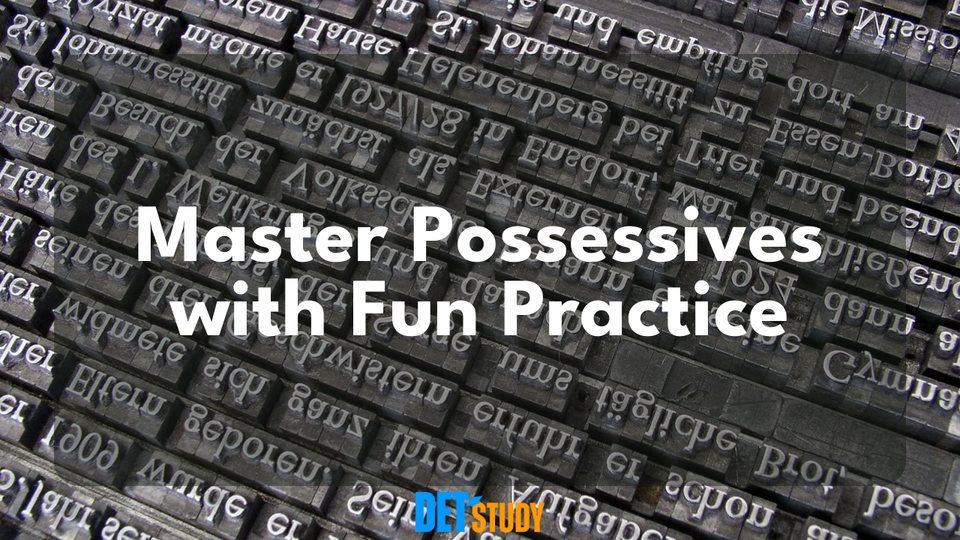Possessive Exercises: Enhance Your English Language Skills with Engaging Practice Activities

When learning English, understanding how to express possession is essential. Possessive forms show ownership or a relationship between things. There are several ways to express possession in English, and here are some key methods:
1. Possessive Nouns
To indicate possession with nouns, you typically add an apostrophe followed by the letter "s" ('s) to the end of a singular noun.
Examples:
- Singular Noun:
-
The cat's toy is under the table.
Here, 'cat's' indicates that the toy belongs to the cat. -
Plural Noun (ending in -s):
-
The students' books were on the desk.
Since 'students' is plural and ends with an "s," only an apostrophe is added. -
Plural Noun (not ending in -s):
- The children's playground is nearby.
Here, 'children' is an irregular plural noun, so 's is added to show possession.
2. Possessive Pronouns
Possessive pronouns indicate ownership and replace a noun phrase. Importantly, possessive pronouns do not use an apostrophe.
Examples:
- Singular:
- This book is mine.
-
Is that car yours?
-
Plural:
- Our home is larger than theirs.
- These are yours, not theirs.
Common Possessive Pronouns: mine, yours, his, hers, ours, theirs
3. Possessive Adjectives
Possessive adjectives are used before nouns to show possession. They must agree with the noun in number but do not use an apostrophe.
Examples:
- Singular:
- My brother lives in New York.
-
Her dress is beautiful.
-
Plural:
- Our plans have changed for the weekend.
- Their children are very talented.
Common Possessive Adjectives: my, your, his, her, its, our, their
4. Double Possessives
Double possessives are used to emphasize the possessive nature, often indicating part of a group from a larger set.
Example:
- A friend of mine came to visit.
This implies the friend is one of several friends you have.
Practice Exercises
To reinforce your understanding of possessive forms, try these exercises:
-
Rewrite the following sentences using possessive nouns: - The coat belonging to Sarah is on the chair. - The bikes used by the children are in the garage.
-
Correct the errors in these sentences: - The dogs' bone is under it's bed. - This is hers' book on the shelf.
-
Fill in the blanks with the correct possessive adjective or pronoun: - This is not my jacket; it must be _ (you). - _ (they) house is the blue one on the corner.
Understanding and practicing possessive forms will help enhance your English language skills, making your communication clearer and more accurate.
When learning English, mastering possessive forms can present several challenges for language learners. Here are some common areas where learners might struggle:
1. Apostrophe Placement
One of the most frequent difficulties is knowing where to place the apostrophe. Here are a couple of rules to remember:
- Singular nouns: Add an apostrophe and an "s" ('s) to show possession.
-
Example: The student's book.
-
Plural nouns ending in "s": Just add an apostrophe after the "s".
-
Example: The teachers' lounge.
-
Plural nouns not ending in "s": Add an apostrophe and an "s".
- Example: The children's toys.
2. Its vs. It's
Confusion often arises between "its" and "it's":
- It's is the contraction for "it is" or "it has".
-
Example: It's a sunny day.
-
Its is a possessive form, meaning "belonging to it".
- Example: The cat licked its paws.
3. Possessive Pronouns
Remembering the list of possessive pronouns and not confusing them with contractions or plural forms is crucial:
- My, your, his, her, its, our, their are possessive pronouns.
- Example: Their house is on the corner.
These pronouns never take an apostrophe.
4. Double Possessives
Sometimes, English allows for the use of double possessives, which can be puzzling. This structure uses both "of" and an apostrophe:
- Example: A friend of my mother's (meaning one of the friends that my mother has).
5. Irregular Possessive Forms
Some possessives are irregular and don't follow the standard rules:
- Irregular Nouns: Some nouns have irregular plural forms with possessives, such as "children's" or "men's", which can be confusing.
6. Cultural Differences in Expressions of Possession
In some languages, the concept of possession is expressed differently, which can lead to errors. English often uses possessives more frequently than other languages.
Practice Makes Perfect
To overcome these challenges, practice through exercises tailored to each type of possessive form. Here are some strategies to practice:
- Identify and correct possessive forms in sentences.
- Write sentences using both singular and plural possessives.
- Practice contrasting "it's" and "its" in context.
- Engage with interactive grammar exercises focused on possessive pronouns.
Understanding and practicing these elements can help students become more confident in their use of possessive forms in English.
Mastering possessive usage in English can be a bit tricky, but with practice and attention to detail, you can improve your skills. Here are some tips to help you understand and use possessives correctly:
1. Understand Possessive Nouns
- Singular Nouns: Add an apostrophe followed by "s" ('s).
-
Example: The dog's leash (the leash belonging to the dog).
-
Plural Nouns Ending in "s": Simply add an apostrophe after the existing "s".
-
Example: The cars' engines (the engines of the cars).
-
Plural Nouns Not Ending in "s": Add an apostrophe followed by "s" ('s).
- Example: The children's toys (the toys belonging to the children).

2. Distinguish Between "Its" and "It's"
- Its: Use "its" to indicate possession. It is similar to "his" or "her".
-
Example: The cat licked its paws (the paws belonging to the cat).
-
It's: Use "it's" as a contraction for "it is" or "it has".
- Example: It's raining outside (It is raining outside).
3. Remember Possessive Pronouns
- Possessive pronouns do not require an apostrophe and should stand alone.
- Examples: mine, yours, his, hers, ours, theirs.
- Example in use: That book is hers, not yours.
4. Be Cautious with Compound Possession
- When the ownership is shared, add the apostrophe to the last name only.
-
Example: Brad and Jen's apartment (the apartment shared by Brad and Jen).
-
When ownership is separate, add an apostrophe to each name.
- Example: Mike's and Sarah's cars (Mike and Sarah own separate cars).
5. Use Possessives in Context
- In writing and conversation, use possessives to clarify relationships between nouns.
- Example: John's decision to study abroad was unexpected (the decision made by John).
6. Practice Regularly
- Regular practice with possessive forms helps reinforce your learning.
- Complete exercises, quizzes, and engage in writing exercises where you use possessive forms accurately.
By following these tips and continually practicing, you can master the use of possessives in English and improve your overall communication skills.
Practical Possessive Exercises for Students
Understanding and using possessives is essential for mastering English. Here are some practical exercises to help students practice using possessive forms:
Exercise 1: Fill in the Blanks
Use the correct possessive form of the nouns in parentheses to complete the sentences.
- This is (John) ____ car.
- The (cat) ____ toys are on the floor.
- I borrowed (Anna) ____ book last week.
- (Children) ____ games are often very imaginative.
- We visited (Tom and Lisa) ____ house yesterday.
Exercise 2: Rewrite the Sentences
Rewrite the following sentences using possessive forms.
- The backpack belonging to Peter is red.
- The voice of the singer was amazing.
- The bicycles belonging to the twins are in the garage.
- The decision of the committee was final.
- The stories of the grandparents are fascinating.
Exercise 3: Identify the Errors
Identify and correct the possessive errors in the following sentences.
- The dogs bone was buried in the backyard.
- Janes sister is visiting tomorrow.
- The mens room is on the left.
- We watched the childrens toys get packed away.
- He borrowed his teachers book without asking.
Exercise 4: Create Your Own Sentences
Create sentences using the possessive form for each pair of words provided.
- the teacher, lesson
- Sarah, hat
- the city, mayor
- my brother, friend
- the company, policy
Exercise 5: Match the Phrases
Match the phrases on the left with their correct possessive form on the right.
| Phrase | Possessive |
|---|---|
| The computer of the student | 1. The student's computer |
| The schedule of the bus | 2. The bus’s schedule |
| The garden of the neighbor | 3. The neighbor’s garden |
| The shoes of the children | 4. The children's shoes |
| The project of the team | 5. The team's project |
By practicing these exercises, students can solidify their understanding of possessive forms in various contexts.
When it comes to mastering the possessive forms in English, online resources can be incredibly helpful. Here are some recommended tools and websites that offer interactive exercises, quizzes, and comprehensive explanations:
-
British Council - LearnEnglish - The British Council provides a variety of exercises on possessive nouns and pronouns. Their platform offers practice activities suitable for different proficiency levels, with instant feedback on answers. - Visit their website
-
ESL Games Plus - This site is excellent for learners who enjoy a gamified approach. It features possessive form games and quizzes that make learning engaging and fun. - Explore ESL Games Plus
-
English Club - English Club offers clear, accessible explanations about possessive nouns, pronouns, and adjectives. Along with the theory, you can find exercises to test your understanding. - Check out English Club
-
ESL Lounge Student - A great resource for learners and teachers, ESL Lounge Student provides a wide range of possessive form worksheets and interactive quizzes that cater to different learning levels. - Visit ESL Lounge Student
-
Grammarly Blog - For those looking to understand the nuances of possessive forms, Grammarly's blog offers detailed articles that explain the differences and uses of possessives in English. - Read Grammarly's articles
-
Khan Academy - Known for its comprehensive and structured learning environment, Khan Academy offers video lessons and exercises on possessive nouns and pronouns, perfect for visual learners. - Access Khan Academy
By using these resources, learners can practice and enhance their understanding of possessive forms effectively, ensuring they apply these forms accurately in their written and spoken English.
DET Study provides an extensive suite of over 15,000 practice questions, focusing on leveraging adjectives and adverbs to fortify your grammatical skills. Regular practice with these targeted materials ensures that you approach the Duolingo English Test with enhanced confidence and precision, ready to achieve your desired scores.
🎯 Need more practice? Check out DETStudy.com for expert resources, 15,000+ practice questions, and AI-powered writing and speaking feedback.
Frequently Asked Questions (FAQ)
What is the purpose of possessive exercises in English language learning?
How can possessive pronouns improve my English communication?
Are there any common mistakes to watch out for in possessive exercises?

